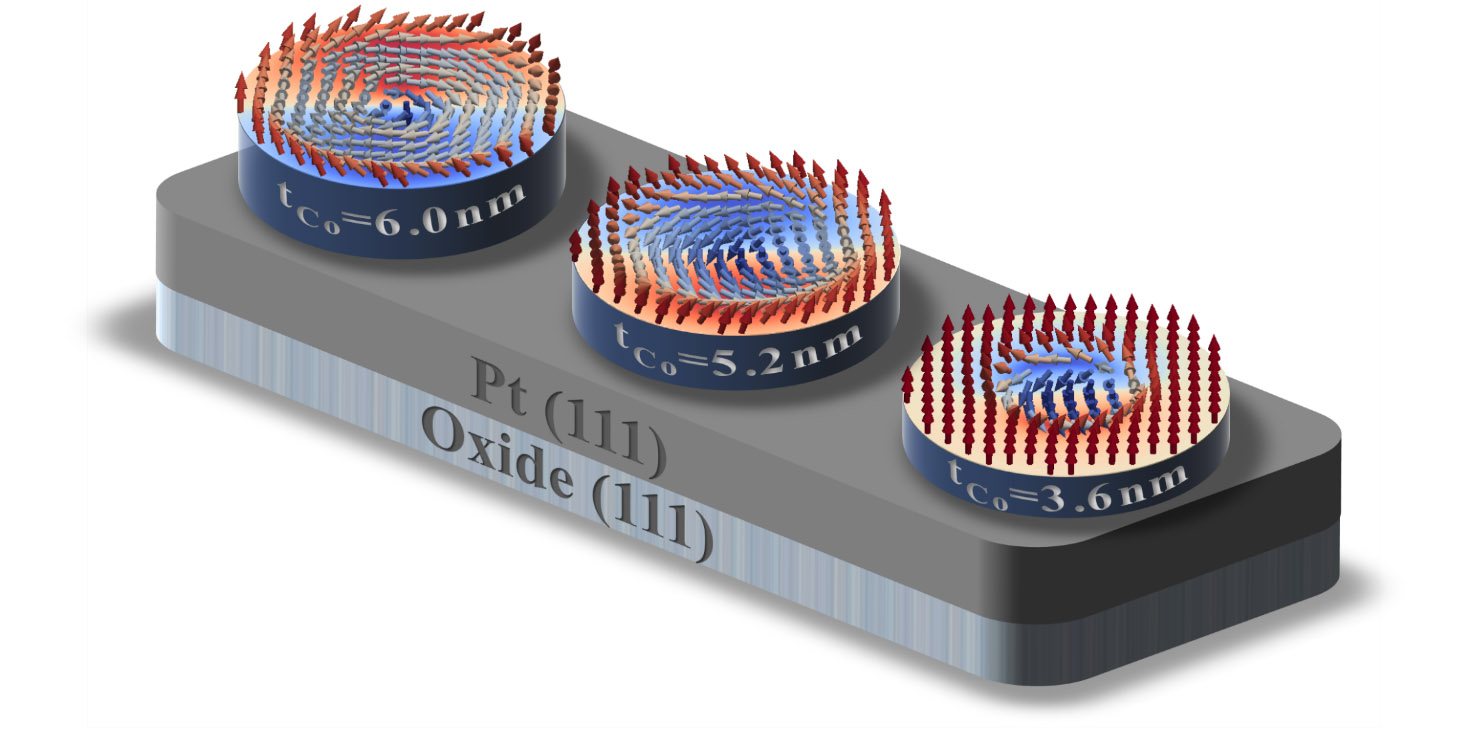Stable skyrmions in graphene-based epitaxial trilayers
05.06.2020
 |
|
Intrinsic mixed Bloch-Néel character of skyrmions in Graphene-based confined nano-dot geometry for different ferromagnetic thicknesse. Image credit: ACS Appl. Mater. Interfaces. |
Recent advances on the stabilization and manipulation of chiral magnetization configurations in systems consisting in alternating atomic layers of ferromagnetic and non-magnetic materials hold promise of innovation in spintronics technology. The low dimensionality of the systems promotes spin orbit driven interfacial effects like antisymmetric Dzyaloshinskii-Moriya interactions (DMI) and surface magnetic anisotropy, whose relative strengths may be tuned to achieve stable nanometer sized magnetic objects with fixed chirality, which are proposed as carriers of information in future spin-orbitronics technology.
While in most of the cases this is obtained by engineering complex multilayers stacks in which interlayer dipolar fields become important, a research team guided by Dr. Paolo Perna at IMDEA Nanociencia and by Oksana Chubykalo-Fesenko at ICMM-CSIC, has considered a simple epitaxial trilayer in which a ferromagnet (namely Cobalt, Co), with variable thickness, is embedded between a heavy metal and graphene. The latter enhances the perpendicular magnetic anisotropy of the system, promotes a Rashba-type DMI, and can sustain very long spin diffusion length. The work, mostly performed by the PhD student they supervise Mr. Pablo Olleros-Rodriguez, consists in the development of a layer-resolved micromagnetic model capable to account for the low dimensionality nature of the interactions, which leads to macroscopic parameters that depend on the thickness of the ferromagnetic layer.
We demonstrate that our model correctly reproduces the experimental magnetization configurations and the spin reorientation transition. In particular, we are able to predict the experimental parameters that will lead to Néel, Bloch or mixed chiral skyrmions. Our results demonstrate that for samples with Co thickness larger than 3.6 nm intrinsic mixed (predominantly Bloch-type) skyrmions are stabilized in 256 nm wide dots.
This work is a collaboration between "SpinOrbitronics" group led by Paolo Perna (IMDEA Nanociencia) and Oksana Chubykalo-Fesenko (ICMM-CSIC) and has been partially funded by the FLAG ERA grant SOgraphMEM, NANOMAGCOST (Comunidad de Madrid), FUN-SOC-RTI2018, SKYTRON-FIS2016, and the Severo Ochoa Programme for Centres of Excellence in R&D awarded to IMDEA Nanociencia.
FLAG-ERA is an ERA-NET (European Research Area Network) initiative that aims to create synergies between new research projects and the Graphene Flagship and Human Brain Project. The goals and activities of FLAG-ERA are, in close connection with the Flagships, to set up mechanisms to facilitate and encourage integration of nationally/regionally funded research into the Flagship work plans. The project SOgraphMEM, recommended for funding to the national/regional research funding organisations of FLAG-ERA by the Joint Translational Call (JTC) 2019 Steering Committee, has recently been chosen as Partnering Project of the Graphene Flagship amongst other 16 newly-funded projects that will receive around €11 million in funding overall. SOgraphMEM is coordinated by Dr. Perna and will investigate the promising of graphene in spintronics, particularly it will test specific materials for a novel branch of spintronics called spin-orbitronics exploiting electron spin and momentum.

Reference:
Pablo Olleros-Rodríguez, Ruben Guerrero, Julio Camarero, Oksana Chubykalo-Fesenko, and Paolo Perna. ACS Appl. Mater. Interfaces 2020, 12, 22, 25419–25427. DOI: https://doi.org/10.1021/acsami.0c04661
Contact
Dr. Paolo Perna
http://www.nanociencia.imdea.org/spinorbitronics/group-people
https://sites.google.com/site/spinorbitronics/
IMDEA Nanociencia Outreach Office
This email address is being protected from spambots. You need JavaScript enabled to view it.
+34 91 299 87 12
Twitter: @imdea_nano
Facebook: @imdeananociencia
Fuente: IMDEA Nanociencia



